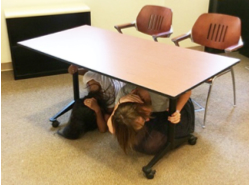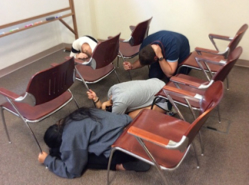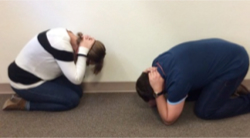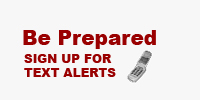Earthquakes
Earthquakes are unpredictable and may happen where you live, work, or travel. Most injuries in earthquakes are from falling or flying objects.Every year we join millions of people worldwide who are practicing how to be safe during earthquakes as part of the Great ShakeOut.

People get injured by falling objects and when they try to run, which is why we will practice Drop, Cover, and Hold On

- Drop to the floor where you are.
- Cover your head and neck with one arm/hand.
- Nearby tables or desks: crawl underneath and Hold On to your shelter with your free hand.
- Rows of chairs: get between the rows and Hold On to a chair with your free hand.
- Alternative: get next to a wall with no windows and cover your head and neck with both arms/hands.

- Step back from the lab table.
- Drop to the floor on your knees next to a wall, away from glass and other hazards if possible.
- Cover your head and neck with your hands and arms.
- Hold On to something sturdy if possible.

- Wait a minute for everything to settle.
- Before getting up, look around for hazards (including above and behind you)
- Carefully exit the building if instructed.
Questions to Consider After the Earthquake Drill
- Have you registered for the Campus Emergency Notification System? This is where you will receive SUU Alerts and updates in an emergency.
- If you were at home during an earthquake, what might fall on you? Can you move those items or secure them so they won’t cause injury?
- Do you always keep your cell phone and computer charged? If you have a car, do you always keep the gas tank at least half full?
- How would you contact your family in case of an emergency? Do you have a plan for checking in with one another and responding to emails/texts/etc.?
- ATMs may be offline after a major earthquake. How long can you live on the money you have right now?

